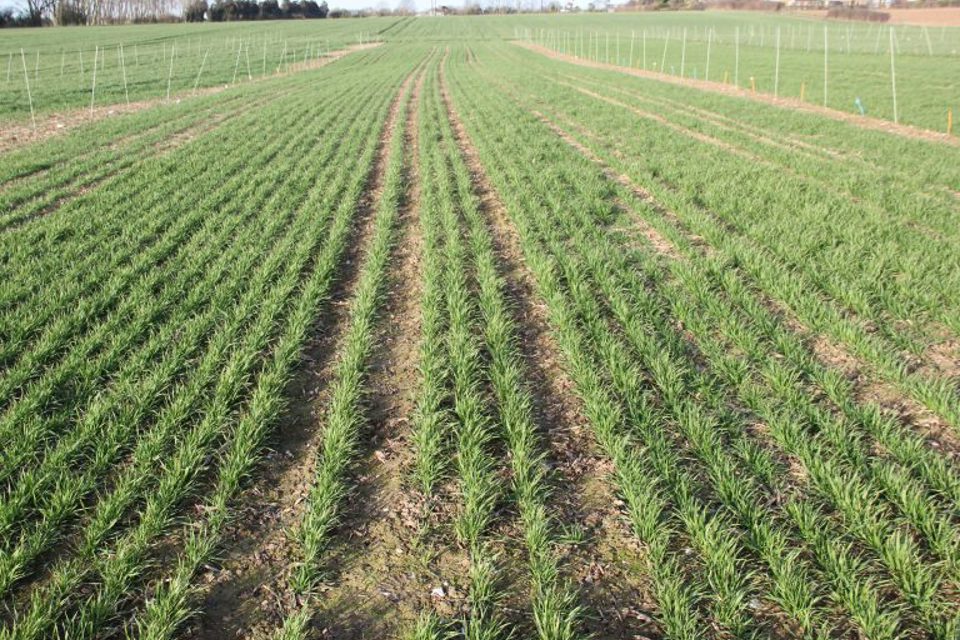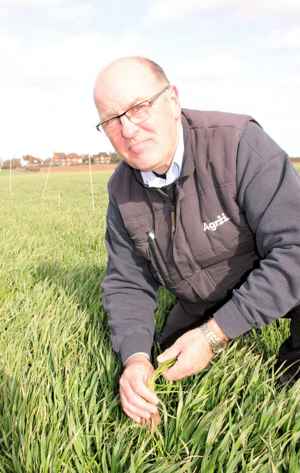
Trials help Kent grower tackle Italian ryegrass
Case Study - 30.06.17
Philip Bartholomew is battling a ‘nightmare’ weed on his 135ha farm near Sittingbourne in Kent – Italian ryegrass.
Insights from Agrii’s black-grass research is helping him gradually fight back though. Central to success are key elements of Agrii’s Stow Longa black-grass management programme, even though Philip has never had a problem with that particular weed.
Compared to black-grass though, Italian ryegrass is known to be twice as competitive and spread far more rapidly. Getting a grip on it is therefore vital to maintain crop yields.
However, as if to make matters even more challenging, the Grove End Farm population is developing resistance to all the most effective post-em herbicide options.

Philip Bartholomew
A ‘nightmare’ weed
Last Spring, Italian ryegrass infestations were so bad in parts of two fields that 15% of the farm’s milling wheat crop had to be destroyed with Roundup to prevent the ryegrass seeding.
“It was a nightmare,” says Philip. “We had to bite the bullet and spray-off the worst-affected areas because it was hard to see the wheat for the ryegrass in places.
“What makes things worse is that we’d always prided ourselves in keeping our clay loam ground very clean, preventing problem weeds like black-grass gaining any sort of foothold by scrupulous attention to machinery hygiene.
“Until 2010 that was, when we pulled out of doing ELS buffer strips that were causing us serious headaches with local dog-walkers. Since then increasing amounts of ryegrass have been coming in from the field edges, reaching crisis point in 2015/16 when the weather really got in the way of our post-em spraying.”
As a direct result, the wheat herbicide bill for the farm has escalated from £25/ha for a simple flucenacet/ DFF pre-em followed by a spring SU, to around £120/ha for a stacked pre-em, peri-em and early post-em programme. Even this has had to be followed-up with a spring application of pinoxaden this season.
“With our most recent testing showing early indications of resistance to Axial as well as both Broadway Star and Atlantis, we’re fast running out of chemical control options,” says Nick McMullon, the farm’s Agrii agronomist.
“Just like black-grass, we’ve got to get the right cultural controls in place very rapidly if wheat is to continue to be a viable here – the question is exactly what controls will be best.
Putting controls to the test
Behaviourally, Italian ryegrass is very similar to black-grass, says Nick: “Over 90% typically emerges before December, it can persist in the soil for a good five years, and it will not emerge from seeds buried at reasonable depth.
“This means a well-proven Stow Longa recipe should be effective – delayed wheat drilling or Spring cropping, rotational ploughing, and minimum soil disturbance at drilling. The only way to be sure though, is to try it out, which is exactly what we’re doing.”
Supported by the Agrii Technology Centre research team, Nick and Philip are running trials on cultivation systems and herbicide regimes trials in milling wheat at the heart of the rotation and spring barley, which is being grown for the first time.
Initial results from the winter wheat trials show a ryegrass population of almost 250 plants/m2 in the untreated field plots.
In the plot using the farm’s standard establishment practice, average control of the ryegrass was 55%. This included discaerator cultivation immediately after harvest, a single glyphosate spray, and a further cultivation pass ahead of power harrow drilling in late September.
A simple pre-em resulted in 23% control, while the best pre-em/peri-em/post-em combination resulted in 91% control.
In complete contrast, an identical initial cultivation and glyphosate regime followed by minimal disturbance drilling on the same date, gave in excess of 99% control with every herbicide regime.
Similarly excellent ryegrass control was achieved regardless of establishment system or herbicide regime from late October drilling.

Nick Mcmullon Checks Ryegrass Levels In The Grove End Farm Trials
Key trial learnings
“This has underlined how important it is to either delay drilling sufficiently or, if we can’t take this risk, to wake-up the least amount of ryegrass seed just ahead of and at planting,” says Nick.
“We’ve still been able to achieve a high degree of control where we did neither. But only from the most robust chemical regime and in a season in which we achieved reasonable residual activity.
“This is simply too high a risk – not to mention cost – for us. Especially so with the increasing level of herbicide resistance we’re encountering here. It will be very revealing to see the yields and margins from the various treatments after harvest.
“Equally interesting will be the results of the parallel trials being run by the Stow Longa team with different varieties, seed rates and establishment regimes in the field of spring barley we’ve put in following one of the wheat crops we had to partially spray-off last year.
“Despite this, a further two autumn applications of glyphosate and ploughing, we had to go in with another dose of glyphosate ahead of our Spring drilling to deal with continually emerging ryegrass in the worst areas.
“With the sort of warm winters we’re getting these days, this suggests the weed may not necessarily always follow its classic autumn emergence pattern,” he says.
Managing the problem
While there is clearly value in delaying wheat drilling, Nick and Philip feel that the risk of doing so on heavy ground that can rapidly become impossible to work in the wet, is considered too high.
Nor has winter barley ever done well on the farm. So replacing September-sown wheat with the more competitive cereal is also unattractive. This makes the alternatives of reduced cultivation and Spring cropping all the more important.
“Following the success of the black-grass work at Stow Longa, we see spring barley as an important part of our solution,” says Philip. “We’d never have considered the crop here five years ago. However, we’ve brought in a good 8.5t/ha from it so we know we can grow it.
“Although we’re not in the right area for an Explorer contract, we do have good local markets for high nitrogen malting grain, as well as straw for livestock feeding.
“So this season we’ve drilled 30ha of Propino with a small amount of Vertigo spring beans alongside our Autumn mainstays of Skyfall milling wheat and Elgar oilseed rape.
Using lessons learnt on farm
The farm’s Agrii trials have been a real eye-opener in direct drilling, says Philip.
“We had a Bettinson DD ages ago but, like many, went back to ploughing. We’ve reduced tillage progressively since then and today’s no-till drills look like a different proposition entirely.
“They cultivate the slot well without smearing and close it effectively around the seed. The fact that they leave the rest of the soil undisturbed really cuts down on all-important weed emergence in the seedbed.
“Depending on how the trials yield, we plan to use a contractor to direct drill much of our wheat in the future. We may even look to direct drill our oilseed rape following the spring barley.
“More oilseed rape is another thing we’re actively considering. We’ve brought in up to 5t/ha in the past and we’ve yet to encounter many flea beetle problems. At the same time, it gives us good grass weed control.
With rapeseed margins looking good against second and subsequent wheats, Philip is considering switching from OSR every four years as a main break for consecutive wheats. Instead he would introduce a three-year rotation of rape, wheat and spring barley.
“Whatever we do we’ll be building as much flexibility into our system as we can,” he says, “and ryegrass control will be the imperative driving all our decision-making.
“We may have been able avoid black-grass problems here so far, but the ryegrass we have is at least as big a threat, if not greater. With the best research-based support, we simply have to keep on top of it if our arable business is to continue to be sustainable in the years ahead.”
Agrii Case Studies: Stories of farmers we’ve worked with
Join Our Community

Agrii X
We love engaging with clients and partners. Give us a follow and let's share stories for the community.

Agrii Instagram
A picture paints a thousand words. Follow us on Instagram to see what we are up to.

Agrii Facebook
Follow us on the worlds biggest social media site for the latest news and events straight to your feed.

Agrii LinkedIn
If you are all about the business, connect with us on LinkedIn to build your network
Stay In Touch

Journal Sign-Up
Receive email updates on topical news and information from around Agrii and UK Farming.

Listen To Our Podcasts
Listen to the Tramlines Podcast. Fortnightly chat about agriculture and trials with your host Tony Smith.

Agrii Insights
Read essential agri intelligence for profitable farming.

Find an Event
Join us for our upcoming events and tours.



